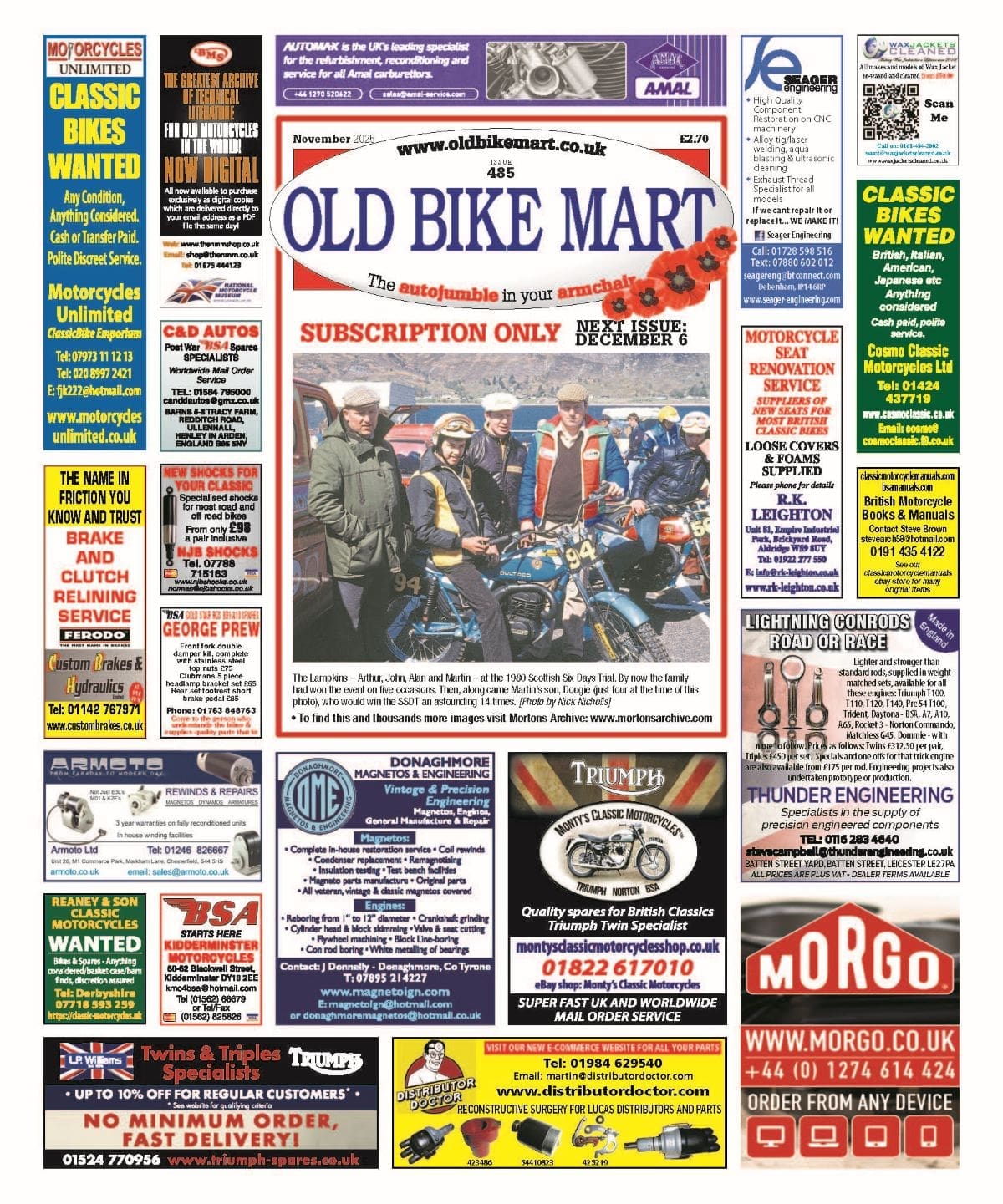One oft-overlooked aspect of the First World War was the role played by the despatch rider. Dave Minton recommends an extensive book on this very subject…
My evenings have been spent recently engrossed, and I use the word intentionally, in a study of dispatch riding through the Great War of 1914-18. Before going further let me say that people without a motorcycling interest (how do they survive?) to a man just look blank and grunt dismissively when asked about dispatch riding through the Great War. Women tend to smile sympathetically as if faced by a familiar yet kindly simpleton. Even students of the War’s history manage little more than a puzzled frown. Yet here we are about to discuss a pretty hefty book concentrating largely on what has been a hidden contribution to the eventual allied victory. And discuss it we will because it’s much too good to dismiss in a few lines of a congratulatory critique, for while the subject matter appears to be small its presentation is a revelation of events writ large.
Enjoy more classic motorcycle reading, Click here to subscribe to one of our leading magazines.
San Fairy Ann (we’ll return to this shortly) was written by Michael Carragher. I freely confess that Michael is a friend of mine. We have known each other since the early Eighties when he was editor of Bike Ireland. Since then Michael has taught English and history in Ireland and the USA, won himself an MA with Distinction in First World War Studies at Birmingham University, as well as collecting the highly acclaimed Max Rosen prize five years ago.
An intellectual without ‘hands-on’ experience of life? Well, so you might believe about an author with such a background, but Michael’s every day transport is a Beemer Boxer RT wholly maintained and repaired by himself. Prior to that, his preferred choice was a big Guzzi Convert he had modified to drive through a five-speed box and onto which he had also very successfully grafted a single carburettor (from a Harley-Davidson). His current project is the restoration of a 350cc Swiss ex-army Condor, which in reality was, or is, a modified Ducati. And he’s toured the USA; all this I tell you so you might have a clear picture of the author.
The book – its title. If you are old enough to personally remember life during WW2 then you will probably recall the popular fatalistic quip ‘San Fairy Ann’. It was handed down from the WW1 Tommie’s crude translation from French and it implies something pretty similar to the Japanese, ‘Whatever will be, will be’ or the British, ‘It’s in the lap of the gods’. Why? Because the life of a WW1 dispatch rider was not only dangerous, it was full of the unexpected and a rider’s survival depended almost wholly on himself.
You may well find the Great War, especially its origins, confusing, especially if you have been influenced by modern anti-imperialists who blame it all on an inevitable clash of ruthless ambitions between the European Great Powers. What Carragher has done is to create in his masterful Introduction chapter as clear and concise an account of the origins of the Great War as you will find anywhere. Into this blessedly simple perspective he places the dispatch rider and his machine. For instance, Chapter 1, Iron Men, Steel Machines, provides the reader with as clear an account of the realities of international industrialisation as might be found anywhere; and this the reader needs if he or she is to grasp the realities of what is to come.
By Chapter 2, To War on Two Wheels, the dispatch rider proper arrives. ‘Given that (the motorcycle) had been invented in Germany – the Kaiser’s armies underrated the motorcycle – being so Teutonically technocratic that they relegated motorcycles to a position of tertiary importance and placing their faith in telegraph and wireless, with critical consequences (of unreliability)… (yet) the motorcycle was invaluable, perhaps literally essential to communications…’
Then there’s Chapter 3, You Could Get Killed Out There, wherein Carragher on the strength of approximately seven (!) years research reveals less about the progress of the War and its consequences, and more on the realities of dispatch riding through it. A Corporal Best records: ‘I had to spend the night on the road… went out to find some Territorials reserve and an ambulance and had a broken chain which I replaced with the spare, the cover of my carburettor got lost… replaced by a tin lid… cleaned mud from the float chamber… lack of carbide… three inches of mud on the road clogged wheels every hundred yards… spring on the contact breaker broke… However, one takes things very calmly…’ Later he notes that following a snowfall glutinous mud depth had increased to between six and 12 inches: ‘Not ideal for riding.’ !
| RT BMWs on Now… |
Just what did the Don Rs contribute that was so invaluable? Stated all-too briefly here, although Carragher explains in concise detail, when the tiny BEF (British Expeditionary Force) conducted its fighting retreat in the first year of the War it dismayed the German army sufficiently to ensure that it probably could not win, at least not in the walkover it had presumed awaited it. And one of the great contributions to British success was the excellence of its communications. While radio-phone existed it was primitive and unreliable, so as the German army persisted hopelessly with its unreliable radio-phones, the British kept in touch through good old Don Rs.
Why, then, in view of their essential rôle in warfare, have the heroic dispatch riders been so shamefully overlooked in military history? Carragher discusses this in his introduction and concludes that, following the popular derring-do profile of the War’s early period motorcyclists, Don Rs were eventually overshadowed by the rising glamour of the latter period’s aircraft and tanks which were perceived to be the machines of victory. And, of course, the rise of reliable radio-phone communication had more-or-less replaced the doughty Don R as a vital high-speed messenger. Thus, until now, has the case rested. But as Carragher summarises, while it is obvious that the Don R did not win the war, without him in the early period victory in the later years would have been improbable.
Should your preference be for the fact and figures of the bikes, then ask yourself a few questions, such as, which models were supplied in greatest volume, or how did British machines compare to German, or which were the best of our own makes, or did the French use them, or whether motorcycles were effective in the Africa theatre (oh yes there was, even in WW1), or is it true that belt-driven bikes were immobilised by slippage in wet weather? All these are raised plus a great many more than you might never imagine.
Then there’s the case for the sidecar outfit. Could it really have offered any performance advantages over cars and lorries? Was its employment as a machine gun carrier fact or fiction? Which were the best sidecar bikes?
A book review must stop somewhere and this is as good a place as any. Having studied San Fairy Ann from a critic’s perspective I now go to sit in my favourite armchair with a Bladnoch single malt beside me and read it purely for pleasure.
RC Reviewer: Dave Minton
———–
San Fairy Ann, Motorcycles and British Victory by Michael Carragher is published by FireStep Press, ISBN 978-1-908487-38-4, RRP £17.99.

Photos by Oisin Breathnach
Like this page? Share it with these buttons: |
Search for books and magazines on



